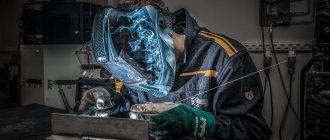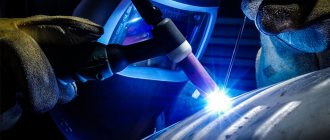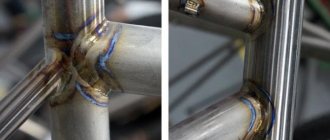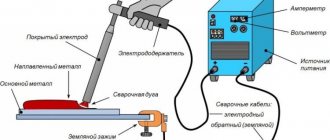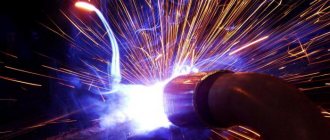Often there is a need to connect parts, for example, made of aluminum, copper, titanium, etc. In such cases, argon arc welding is used, which is a hybrid of electric arc and gas. Before cooking with argon, you need to learn how to maintain the distance between the part and the electrode and how to operate the burner correctly.
Argon welding is very popular.
Definition of argon welding
In this type of welding, an electric arc burns in an environment of inert gas argon, which protects the surfaces being welded from exposure to oxygen.
Sometimes argon is replaced with helium: it has similar properties, but is more expensive, so it is used less often. The principle of operation in helium and argon environments is the same.
Application area
This type of welding is widely used not only in various industries in arc, plasma or laser welding. Home craftsmen actively use it in everyday life to join high-alloy alloys and rare earth metals. Gas welding is quite dangerous, and it is not worth storing such equipment in the garage, but this does not apply to argon, because. it is completely safe and does not explode.
There are steel cylinders with this gas with a capacity of 15 to 40 liters on sale. If you need to cook infrequently, you can purchase a small tank that will last a long time. Since no harmful toxins are released when working with such equipment, it is not dangerous for strangers to be near it.
General principle of technology
Inert gas protects the welding site from the negative effects of oxygen. Due to the potential difference between the electrode and the workpiece, an electric arc appears and a high temperature is created. The edges of the parts begin to melt, resulting in the formation of a weld pool. An additive is constantly supplied to this zone, as well as argon under pressure: it protects the materials being welded from oxidation.
The welding principle is based on joining metal surfaces in a protective gas environment.
To understand how to cook with argon correctly, you need to understand the structure of the main working element of the equipment. This is a burner in which a tungsten non-consumable electrode and a nozzle through which argon is supplied are fixed. When the thickness of the workpieces being joined is small, welding can be performed without the use of filler material.
Connection to the electrical network is carried out in 2 ways:
- straight polarity (minus is applied to the workpiece, and plus is applied to the working rod);
- reverse (here everything is the other way around, but this leads to unstable arc burning and premature wear of tungsten).
Most often they work with direct current, and when welding aluminum and beryllium they use alternating current.
Properties of gas and effect on metal
Due to its physical and chemical characteristics, argon does not enter into chemical compounds with other substances: even at high temperatures it does not interact with oxygen. It can be used when welding various metals and alloys in industrial and domestic conditions. Inert argon almost completely isolates the molten material in the weld pool from oxygen in the air, so the seam does not oxidize .
Basic properties of argon:
- almost 40% heavier than the components that make up the air, so it easily displaces them from the welding area;
- does not take part in the direct welding of metals and does not affect their structure in any way;
- when reverse polarity is used, it acts as an electrically conductive medium.
Features of using the inverter
When performing argon arc welding in industrial and domestic conditions, an inverter is used. This equipment is used to convert alternating current into direct current. Domestic power grids often experience voltage surges, but modern inverters are well adapted to this and provide stable output values.
When performing argon arc welding, inverters are used.
The devices used in this type of welding are distinguished by their low weight and dimensions, high reliability and ease of maintenance. All this allows novice welders to easily master the equipment used and the argon welding process itself.
Inverter welding of stainless steel in an argon environment, compared to other methods of joining such alloys, is simple. Here the welder only needs to move the torch correctly along the seam.
If the edges of the workpieces are tightly connected, then the work can be done without the use of filler wire.
Keep clean
Surface cleanliness is an important indicator for every welding process, but it is especially important for argon welding. Surface contamination can lead to the formation of pores and, therefore, require additional labor to correct them. This is especially important when TIG welding expensive metals such as titanium, aluminum and copper.
Before starting the process, the surface must be cleaned with a clean, dry and soft cloth using cleaning and degreasers to remove oils, grease and dirt. For titanium and its alloys, the fabric must additionally be lint-free and you must work with nitrile gloves that are resistant to oils and grease. When choosing a cleaning agent, pay attention to the fact that it does not contain chlorine. it can lead to health problems.
Due to the high temperature of the welding arc, chlorine evaporates and enters the welder's lungs.
Proper handling of the filler material is also important. Keep the rods (or pieces cut from the wire spool) clean, dry and sealed in a container. To prevent oxidation, it is necessary to maintain humidity and ambient temperature in storage areas in accordance with the recommendations of the manufacturer of these welding materials. Proper storage of basic materials is an important factor. Cross-contamination with particles of another material lying nearby or during stripping in close proximity to the TIG welding site can cause the formation of defects in the weld. To prevent contamination, it is necessary to use special abrasive materials and brushes designed for this type of metal. It must be borne in mind that titanium and magnesium abrasive dust is flammable and can have a detrimental effect on the weldability of other metals. Abrasives for these metals should be stored away from open sources of fire and separately from other materials.
In the process of performing all work related to welding stainless steel, it is necessary to use equipment and tools designed exclusively for this group of steels. Stainless steels must be protected from possible contact or contamination with lead, zinc, copper and its alloys, as well as unalloyed and low-alloy steels. More detailed information about the general requirements for welding stainless steel can be found in the video.
Types of argon welding by technology
Depending on the method of execution, there are several types of argon welding.
We recommend reading: How to cook steel in argon
Manual
With this method, the welder uses only non-consumable tungsten rods and independently supplies the torch and additive.
With the manual method, the welder independently feeds the torch.
Mechanized
This type is also called semi-automatic, because. here the work performer manually operates only the torch, and the filler wire is fed mechanically. This principle is often used when performing argon welding of stainless steel parts using a semi-automatic machine.
The mechanized method is also used when working with a consumable electrode.
Fully automatic
The use of an automatic type of argon welding provides that the operator remotely controls the supply of wire and torch. The most modern systems are completely robotic and operate without human intervention. The creation of stainless pipelines using this method is more efficient. Automatic welding with a non-consumable electrode in an argon environment is most often used in various industries; it is irrational to use this type at home.
Automatic welding is used in various industries.
Features of working with metals that are cooked with argon
The properties of argon allow this type of welding to be used not only in a wide variety of industries and everyday life, but also to work with cast iron, stainless steel, aluminum, copper, and other ferrous and non-ferrous metals and alloys.
Aluminum
Argon arc welding is practically the only method that allows you to reliably connect parts made of aluminum and its alloys. This is a common material both in everyday life and in production. Difficulties in carrying out welding work arise due to the rapid formation of an oxide film on its surface, which interferes with making a high-quality connection.
The problem is that the melting point of the oxide is much higher than that of aluminum itself. Supplying argon to the weld pool allows oxygen to be displaced from it, so the oxidation process does not start. As a result, the metal and additive melt at a suitable temperature, and the seam is strong and beautiful.
The work is performed by alternating current. With straight polarity, a stable short arc is obtained, but its power is not enough to destroy the oxide film. Reverse polarity leads to an increase in the melting temperature due to cathodic purification of aluminum oxide, which improves the quality of the weld, so the work is performed in this way.
Argon arc welding allows you to reliably connect aluminum parts.
You can cook aluminum with direct current, but in this case you need to use helium. It costs more and requires more qualifications from the welder.
Regardless of the method of welding aluminum and the skill of the work performer, preliminary preparation of parts is important. This stage cannot be neglected.
Surface cleaning is carried out in the following order:
- The workpieces are degreased with a solvent.
- The oxide film is removed mechanically or chemically.
- The cleaned surface is dried.
Copper
One of the positive properties of copper is its high resistance to corrosion and aggressive influences. If it is necessary to weld copper parts, the work is performed with direct current. In this case, the electrodes can be consumable and non-consumable.
Welding of copper parts is carried out using direct current.
The additive is made of copper or a copper-nickel alloy, in the form of wire or rods. To join parts thicker than 4 mm, they are preheated to 800 °C. Copper has high thermal conductivity, so the edges of the parts must be cut before starting work. For workpiece thicknesses up to 12 mm, it is enough to process only 1 edge.
Ferrous metal and argon
Ferrous metal can be welded well using ordinary methods. The use of the argon-arc method in such cases makes it possible to obtain an even better quality connection. Use an additive without a special coating, because Argon reliably protects the weld pool from the negative effects of oxygen.
Before work, clean the surface of the future connection. If there is any remaining oil on it, remove it with a solvent. After this, the flux is laid out: it will help preserve important elements in the composition of the workpieces being joined and ensure the correct process parameters.
Ferrous metal is welded in the usual way.
During welding, the tool is brought to the parts when a weld pool is formed. It is gradually advanced and at the same time the additive is supplied.
To ensure that the seam has the same consistency along its entire length, it is not recommended to stop the process.
Stainless steel
Working with stainless steel is quite difficult. Often the welds begin to crack and come apart. To prevent this from happening, such workpieces must be joined using argon arc welding.
The technology for welding stainless steel is the same as simple, but there are several nuances:
- the additive and non-consumable electrode can only be moved along the seam; no movements can be made across it;
- to obtain a better quality weld, the joint from the front and back sides is blown with argon, but this leads to an increase in gas consumption;
- the additive should not go beyond the zone protected by argon;
- The tungsten rod must not be touched to the surface of the work being welded, even during ignition of the arc (special plates are used for this).
We recommend reading How argon welding is performed
Stainless steel must be joined using argon arc welding.
As when welding other metals and alloys in an argon environment, after finishing welding stainless steel, you cannot immediately stop the gas supply. This is necessary to cool the electrode and seam and prevent oxidation. It is enough to supply argon for 10-15 seconds.
Often in industry and everyday life welding of stainless steel pipes is required. The technology for preparing products is the same as for sheet parts. The peculiarity is that in this case it is necessary to blow argon onto the welding seam on both sides.
This is easy to do from the outside, but to blow it from the inside, do this:
- On one of the pipes, the hole is closed with a fabric, paper or other stopper.
- The joint is covered with tape or tape.
- Argon is slowly let in through the hole in the second pipe so that the plug does not fly out, and it is closed tightly.
- Remove the tape or tape and weld the pipes, as in the case of working with sheet materials.
Correctly sharpen the tungsten electrode
Sharpening a tungsten electrode, more precisely the method and angle of sharpening, has a significant impact on the shape of the arc and its behavior and, as a consequence, on the shape of the weld and the service life of the non-consumable electrode.
For sharpening, it is necessary to use wheels with fine abrasive grains (the ideal option is a diamond wheel). It is advisable to use grinding wheels with a grain size of 40 or less (the size of the abrasive parts is less than 400 microns), since in this case the marks from the abrasive on the surface will be less deep and less precious tungsten will be ground off during the sharpening process. Deep grooves from the abrasive cause energy loss and unstable arc behavior. It is advisable not to work with other materials on the abrasive wheel where the cleaning is carried out. their particles can be deposited on the surface of the electrode.
Sharpening of a tungsten electrode must be done in the longitudinal (along the axis of the electrode), and not in the transverse direction.
Since tungsten electrodes during the manufacturing process have a grain structure that is located along the axis and sharpening in the transverse direction is grinding across the grain. But this is not as significant as the fact that electrons flow with high density along the surface of the electrode and, if the grooves from sharpening are located across it, it is more difficult for electrons to overcome them. Since the arc looks for places with the least resistance, it may not occur at the end of the tungsten electrode, but in the grooves from grinding and will rotate around the pointed end, which in turn causes overheating of the electrode and its rapid wear.
If the abrasive marks are located lengthwise, electrons flow evenly to the pointed end of the electrode with less resistance. In this case, the arc ignites at the end, is more stable and heats up the tungsten electrode less, which increases its service life.
During the sharpening process, make sure that the metal does not overheat. A sign of overheating is a change in the color of the surface and indicates that oxides have formed on the surface, which have greater resistance than tungsten and will prevent the arc from igniting.
The sharpening angle of the tungsten electrode plays a major role when welding with argon.
The blunter the sharpening angle >30°:
- harder arc ignition;
- narrower weld seam;
- more welding current is required;
- increasing the possibility of arc wandering;
- increasing the depth of metal penetration;
- longer service life of the tungsten electrode.
The sharper the sharpening angle <30°:
- easier arc ignition;
- wider weld seam;
- less welding current is required;
- reducing the possibility of arc wandering;
- reducing the depth of metal penetration;
- shorter service life of a tungsten electrode.
During the AC argon welding process, a significant amount of heat is generated at the end of the non-consumable electrode, which melts the tungsten, so it is necessary to make a slight blunting, which will allow the formation of a ball of molten tungsten at the end.
The tungsten electrode sharpening machine allows for perfect sharpening.
Types of welding equipment
The welding in question is used when connecting different products.
To perform such work, a certain type of welding equipment is required:
- specialized - used for working with similar parts (round frame, I-beam, etc.);
- special - used in large enterprises where there is mass production of parts of 1 standard size;
- universal - used for any connections made using argon welding, incl. and when working with stainless steel with semi-automatic equipment.
To perform the work, specialized equipment is required.
Technical characteristics of argon arc welding
Argon is used primarily to displace air from the welding environment and reduce to zero the interaction of the molten edges with air, the ingress of which can lead to treachery.
Initially, this technique was used for welding aluminum surfaces (argon arc welding of aluminum). All welding is done using droplets of molten metal (large droplet and drip).
Argon burners and their features
An electrode is attached to the torch (voltage is supplied to it), as well as a nozzle (through which argon enters the work area during welding).
When choosing a burner, the following criteria are taken into account:
- power and current, which are the maximum allowable for the model in question;
- The kit includes a holder for a tungsten rod;
- the material from which the nozzle is made (it is better if it is ceramic);
- cooling method (this is important when working with thick and thin-walled workpieces);
- the possibility of using it with different welding machines;
- length of the electrical cable.
When choosing a burner, take into account power and current.
When the burner starts, liquid immediately begins to circulate in the cooling system, and argon is supplied. After creating the protective layer, a gas arc is formed and the edges of the workpieces are heated. At this time, filler material begins to be supplied. At the next stage, a torch with an electrode and an additive are advanced along the joint of the workpieces.
Consumable electrodes
Consumable tungsten rods are most often used in semi-automatic and automatic argon arc welding. An arc is formed between the surface of the workpiece being welded and the filler material. The cooling system (air or liquid) depends on the performance of the equipment. The operating principle of the burner and the design of the nozzle are the same as in the case of using non-consumable electrodes.
Non-consumable electrodes
When performing manual argon welding, non-consumable tungsten rods are used. They allow high-quality joining of parts made of metals and alloys characterized by high chemical activity, for example titanium, aluminum, magnesium, and stainless steel.
When performing argon welding, electrodes are used.
The electrode is fastened in the current supply collet of the burner, and inert gas is supplied through a nearby nozzle. Depending on the thickness of the workpieces that will be connected, the current strength and diameter of the working rod are selected.
When performing such work, no splashes are generated. To distribute argon evenly, a mesh filter is installed on the burner. The semi-automatic torch additionally has a flywheel, with which the electrode is raised and lowered, and the conductive collet is fixed with a threaded connection so that the tungsten rods can be changed.
Setting up argon welding for aluminum
Setting up the aluminum welding process includes the following steps:
- Setting up the welding machine. The following parameters are set on it: current balance with polarity setting (CLEAN WD.), welding current value (CURRENT), crater filling function (DOWN SLOPE toggle switch) or slow arc decay, gas purge function (POST TIME) for cooling the weld pool and torch .
- Setting up electrodes. The diameter of the electrodes and their projection from the burner are selected correctly.
- Argon flow setting. It depends on the diameter of the filler rod. When welding outdoors, consumption increases.
Interesting: Main types of metal welding
When setting the modes, the ratios given in the table are used:
| Thickness Al, mm | Current strength, A | Electrode diameter, mm |
| up to 1 | 30–42 | 1,6 |
| 1,1–1,5 | 46–60 | 2,3 |
| up to 2 | 71–80 | 2,3 |
| 3 or more | 90–300 | 3,2–5 |
It is necessary to configure equipment and modes with special care. It is better for novice welders to seek help from experienced specialists.
Mode selection
To ensure a high-quality weld when joining ferrous and non-ferrous metals and their alloys, you must choose the right argon welding mode. To do this, it is possible to regulate the current strength in the equipment used.
Current and polarity
For this type of welding, direct or alternating current can be used. When working with reverse polarity, you must be prepared for the fact that the arc will burn poorly and too much voltage will be needed. Charged particles move towards a positive potential, and since This is an electrode, it will overheat and quickly burn out.
When argon welding, you can use direct or alternating current.
When choosing the current strength, take into account the following parameters:
- type of current (direct or alternating);
- tungsten rod diameter;
- thickness of the joined workpieces.
There are special tables with which you can quickly and easily determine the required values. For example, for parts with a thickness of 1-2 mm, you will need an alternating current of 20-100 A or constant, with an increase in thickness to 4 mm - 65-160 A: alternating current 140-220 A, direct current - 250-340 A.
Voltage height
To obtain a high-quality connection, when working with argon welding, it is recommended to set the voltage to no more than 14 V. This allows you to obtain an arc with a length of 1.5-3 mm, which is the optimal indicator for connecting products of different thicknesses, provides good penetration depth, i.e. strong and reliable seam.
We recommend reading: How to cook car wheels using argon
Speed mode
Each master decides for himself at what speed it is convenient to operate the burner. This parameter is selected on site on an individual basis. The main thing is not to do it quickly, because... Welding non-ferrous metals and alloys is a rather complex task that cannot be rushed.
Each master chooses his own speed mode.
Gas consumption
Gas consumption will depend on the size of the seam being created, the diameter of the electrode used, and the material of the parts being connected. In addition, the argon supply rate and external conditions influence (for example, in strong winds, the flow rate increases). Only practice will help you calculate how much shielding gas you will need to complete a certain task.
You can focus on the approximate consumption of inert gas when working with different metals:
- aluminum – 15-20 l/min;
- copper – 10-12 l/min;
- titanium – 35-50 l/min;
- nickel -10-12 l/min.
Pure argon is not used for welding: it contains up to 5% oxygen.
This is necessary to remove existing impurities that simply burn when reacting with oxygen.
Distance to part
When choosing this parameter, everything depends on the thickness of the products being welded and the method of joining them. If the work is done end-to-end, then the electrode should be kept at a distance of 3-5 mm from the part. When connecting workpieces at an angle, this distance is increased to 5-8 mm.
The distance to the part depends on the thickness of the products being welded.
What should you consider when welding aluminum?
Welding aluminum is complicated by the specific properties of the metal. For a quality connection, the following nuances must be taken into account:
- Oxide film. It is formed when metal comes into contact with oxygen in the air. The problem is the large difference between the melting temperatures of aluminum and film: 650 and 2000 °C, respectively. As a result, the oxide remains in the weld, creating its heterogeneity. Aluminum can only be welded efficiently by removing the oxide and excluding contact of the metal with oxygen.
- Low melting point and high melt fluidity. It causes rapid flow of molten metal from the welding zone and through burning of the workpiece. Aluminum begins to enter the liquid phase already at a temperature of 500-520 °C.
- Increased volumetric shrinkage coefficient. An incorrect temperature regime causes stress to appear in the seam, which leads to cracking in it and the seam zone, as well as to deformation of the part.
- High thermal conductivity of aluminum. When welding, the loss of thermal energy increases significantly, which quickly spreads throughout the workpiece. This requires increasing the power of the device.
- Fast crystallization. This property of aluminum leads to the appearance of gas pores in the weld due to incomplete gas release during rapid hardening of the metal.
- Aluminum practically does not change color when melted, which makes visual control of the process difficult.
All these features should be taken into account by a novice welder. Setup requires special care.
Advantages and disadvantages
Among the main advantages of such welding, the following should be noted:
- The operating temperature is low, so the workpieces do not change their shape and size.
- Due to the inertness of argon, the welding zone is reliably protected from the negative effects of external factors.
- A low-power arc ensures high efficiency of work.
- Argon welding allows you to join metals and alloys that cannot be welded by other methods.
- The high quality of the seam allows this method to be used in industries where the requirements for joints are high.
- Automatic welding ensures efficiency and quality when connecting multiple parts with minimal human intervention.
In addition, there is no need to frequently change the electrode; dissimilar materials and alloys can be welded.
Argon welding allows you to join metals and alloys.
Like any other, argon welding also has some disadvantages:
- The complex design of the argon welding machine does not allow an inexperienced welder to correctly set the operating mode.
- When making a connection with a high-ampere arc, it is necessary to additionally cool the joint.
- In order for the inert gas to fully fulfill its purpose, the work site must be reliably protected from wind and drafts.
- The requirements for welder professionalism are high.
Safety precautions
When carrying out work, it is necessary to take into account the presence of electric current, a bright glow of the arc, hot metal that can splash, and high temperatures. The welder must wear a special mask with a blue light filter. Gloves that protect your hands from melt splashes and clothing that can protect your entire body from them are required.
Electrical equipment must be reliably protected. It is necessary to use a residual current device and circuit breakers. The gas cylinder is equipped with a pressure reduction reducer. Before starting work, you must study the safety regulations and strictly follow them.
When welding aluminum one has to face difficulties caused by its specific properties. Argon welding, with the right approach and the use of high-quality materials and equipment, ensures a reliable connection.
How a beginner can learn to cook with argon
For beginners, the argon welding technique is available if:
- Sign up for special courses for beginner welders. Here you will receive the necessary theoretical knowledge and learn to put it into practice. When choosing courses, you need to rely on the experience of friends or reviews of people who have already completed such lessons. Be sure to study the training program and, using common sense, choose the option that suits you most.
- Learn it yourself. If a person has skills in gas and electric arc welding, it is not difficult to master the technique of the argon arc method. It is enough to study the available information and watch thematic videos. Please note that the cost of this inert gas is considerable, so it is better to learn argon arc welding on stainless steel parts. Having gained some experience and studied theory and technology, you can move on to joining products made of non-ferrous metals.
Additional tips from the experts
In order to obtain a high-quality connection when performing argon arc welding with your own hands, the craftsmen give the following recommendations:
- Cleaning the surfaces to be welded from dirt, oil, paint, etc. is a mandatory step. It is performed mechanically or chemically.
- Gas is supplied 20 seconds before the actual welding begins. They take the torch and filler material in their hands, and after applying electricity, they create an arc.
- The burner is led along the joint. You cannot make lateral movements.
- The additive is introduced into the welding zone slowly so as not to provoke the formation of splashes of hot metal.
- The wire is led in front of the torch, making quick translational movements that allow it to be added or removed.
- Achieve the shortest possible arc. This is especially important when working with a non-melting rod: then the seam will be deep and aesthetically pleasing.
- The additive and burner are placed inside a protective argon shell.
- The crater is welded not by interrupting the arc, but by lowering the voltage supplied to the electrode.
- The argon is not switched off immediately after welding is completed, but after 10-15 seconds.
Compliance with argon arc welding technology allows you to reliably join metals and alloys that cannot be welded by other methods. Proper preparation and procedure for performing work eliminate the likelihood of hazardous situations.
